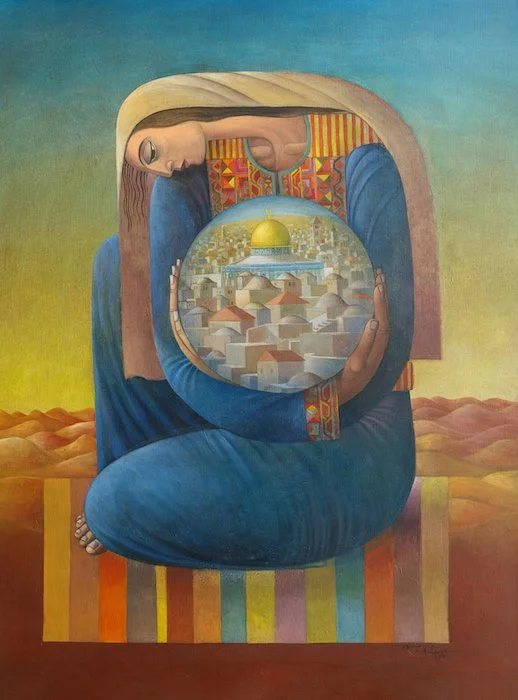Sliman Mansour - Elif Sezen
Sliman Mansour
Sliman Mansour, Woman Carrying Jerusalem [1997]
Aqueous print on archival Canson rag paper, 240 grams
Edition of 75 (+AP)
54 x 39.5 cm
2022, Copyright The Artist
Alt Text: A Palestinian woman is seated on a vibrant, intricately patterned rug, symbolizing the rich cultural heritage she carries with her. She holds the town of Jerusalem in a circle in her arms.
Image sent in by Elif Sezen. Taken from Sliman Manour at Zawyeh Gallery. Go to gallery here.
Born in 1947, in Birzeit, Palestine, Sliman Mansour studied fine art at the Bezalel Art Academy in Jerusalem. Mansour is known for his 1973 work Camel of Hardship depicting an old porter carrying Jerusalem on his back. Mansour has tailored his comprehensive portfolio around the Palestinian struggle, portraying peasants and women in traditional dress in his early work. During the first Intifada against Israeli occupation (1987 – 1993) Mansour and other artists in the ‘New Vision’ art movement started in 1987 boycotted Israeli supplies. Instead, Mansour used local materials like mud and henna in his work.
Sliman Mansour draws inspiration from the subject of the olive tree and has focused on the theme of ‘land’ since 1970. His recent work is centered on the individual figure to convey the ‘different states of exhausting anticipation or loss,’ resulting from his experience of living under the occupation.
Sliman Mansour has held solo exhibitions in Ramallah, New York, Sharjah, Cairo, Gaza, and Stavanger, Norway. His group exhibitions include the Museum of Oriental Art, Moscow (1980), Palestinian Spring, Al-Hakawati Theatre, Jerusalem, 1985; New Visions, Jordan National Gallery of Fine Arts, Amman, 1991; Made in Palestine, Station Museum of Contemporary Art, Houston, Texas, 2003; and Contemporary Graphic Art in the Arab World, Nabad Gallery, Amman, 2010. In 1998 he received the Palestine Prize for the Visual Arts at the Cairo Biennial.
Mansour’s work can be found in international private and public collections, including, the Guggenheim Museum (Abu Dhabi, UAE), Mathaf, Arab Museum of Modern Art (Doha, Qatar), Institut du Monde Arabe (Paris, France), Jordan National Museum (Amman, Jordan), Barjeel Art Foundation (Sharjah, UAE), Darat Al Funun (Amman, Jordan), Salama Bint Hamdan Al Nahyan Foundation (Abu Dhabi, UAE), Dar El-Nimer (Beirut, Lebanon), Birzeit University Museum (Birzeit, Palestine), The Palestinian Museum (Birzeit, Palestine), and Um Al Fahem Museum (Um Al Fahem, Occupied Palestine)
Elif Sezen chose to foreground this painting by Sliman Mansour.
Elif Sezen
The inhabitants
I died today, among many others, my grandpa died too, and our neighbours,
my best friend, the one with braided hair yes, and our sweet sweet doctors,
our motherly nurses … We heard a blast, then a whoosh of some kind,
and all gone. Our hospital was wiped out just like that. I woke up this
morning, thinking, this is just one of those days you know, with bombings
and screams and things … things that terrify me secretively, that don’t show
up on TVs of this planet, or maybe I’m just too little to understand, you see,
I’m a teenager or a child without age or something like that. And maybe it is
OK to die like this, is it? And to live like how we lived, with clean hearts,
daily prayers, with a loaf of bread to share without complaining, with love,
however cliché it might sound, with love we were fed yes, and Alhamdulillah.
So maybe it is OK to leave this world with so many unanswered questions,
so many things that even adults don’t understand. But what is an intellect
when it does nothing other than making a person sit, nod, and push silly
buttons, and make them a servant of some power, or whatever else convenient.
And what about their big minds with PhDs, technological advancements,
anything, anything that makes us the inhabitants of the 21st and so-called
civilised beings that do nothing when it comes to stopping the killings of
thousands of us. And what is an inhabitant then? To be an inhabitant on this
earth, I mean, or on a piece of soil? Is it not to gently walk down the streets,
greet your fellow human with warmth and honour, no matter their race or
religion? This is what we were taught, but … but what is a soul, if it is
scrunched into a ball of no-sense so it can become part of a mass weapon,
a cluster of minds, some unspoken ignorance? What is a human when a heart
is blindfolded, negligent, dull, just like that? I don’t know. I really don’t know
any of these. Not anymore, at least, for I’m dead now! Oh, won’t a cry
for me and write a poem, so I can be blessed a bit and rest in some peace?
This poem was written after the Gaza Hospital blast that took place on Tuesday, the 17th of October 2023. It was first published in Overland Literary Journal on the 25th of October 2023
We thank the author, Elif Sezen, for permission to republish this poem.
Elif Sezen is an Australian/Turkish multidisciplinary artist, bilingual poet/writer and translator. She holds a PhD from Monash University. She lives and works in Melbourne. Elif's practice evolves through various fields: In her work she speculates upon reconceptualising memory traces emerging from familial/personal/collective trauma and loss. This explorative process leads her to a restorative and even a celebrative notion of self-construction, desire, longing and a sense of homecoming. Her poetry collections include A Little Book of Unspoken History (Puncher & Wattmann, 2018) and Universal Mother (Gloria SMH Press, 2016): https://www.elifsezen.com
